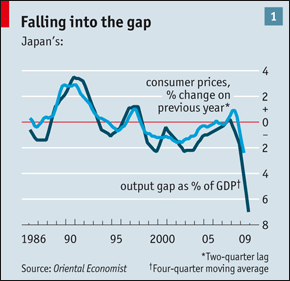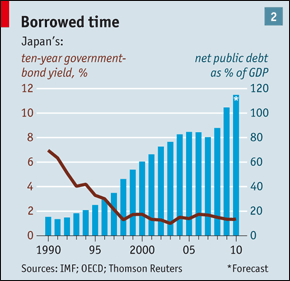Japan's debt-ridden economy
Crisis in slow motion
Japan’s government will eventually have a disaster on its hands if it fails to tackle the deep-seated problems of debt and deflation
Apr 8th 2010 | TOKYO | From The Economist print edition

IF CHINA is the workshop of the world, Japan is the pristine, state-of-the-art laboratory in its backyard. You can see that by the sort of products shipped through the East China Sea in ever-greater quantities from Japan ever since China led a recovery in world trade last year. Forget the digital cameras and other high-tech gadgets. Japanese exports to China are reviving mainly on the back of products that seem to have all the sex appeal of gravel: plastic materials (up 105%, year on year, in January and February), non-metallic mineral goods (up 113%), construction machines (up 152%), textile machines (up 171%), vehicle parts (up 144%) and scientific instruments (up 133%).
Despite appearances, these are all high-tech products or high-value industrial ingredients that feed into a supply chain that snakes through the factories of East Asia to the rest of the world. With public money in China pushing growth there to a brisk canter, and inventories all over the world being restocked, it was only a matter of time before Japan’s exporters began to benefit.
The strength of the recovery has surprised many economists. Japan was one of the hardest-hit countries during the global financial crisis. The collapse in exports helped put a nail in the coffin of the Liberal Democratic Party (LDP), which had ruled Japan for most of the past 55 years, partly on the strength of its ties with Japan’s globe-trotting corporate giants. It was swept from power last September by the Democratic Party of Japan (DPJ), which promised to end the economy’s dependence on fickle exports and promote a more balanced economy.
Fickleness cuts both ways, however. Japan’s recession hit bottom in the first three months of 2009. JPMorgan calculates that over the subsequent nine months the export revival led to annualised growth of 3.1%, outstripping both America and the euro zone. Corporate profits enjoyed their biggest surge on record, albeit from very depressed levels. Unemployment has edged downwards and in January this year monthly wages crept higher compared with a year earlier for the first time in more than 18 months. JPMorgan recently upgraded its forecast for first-quarter GDP growth from 1.8% to 3.5%.
Last year’s rebound in GDP, JPMorgan notes, was only a quarter of what Japan lost in the first 12 months of the crisis, so it still has a long way to go. Unless growth in global demand is sustained, it remains heavily reliant on pump-priming, both in China and at home. The recovery is likely to be given an extra fillip this year by the 2010 budget, passed on March 24th, which includes handouts to families with children under 16. In principle, spurring domestic consumption by any means available is the right thing for the seven-month-old government to do, given the fragility of the rebound. But given Japan’s precarious public finances, a bigger question is: can the recovery be sustained?
The answer, disappointingly, is not for very long. That is because the cyclical upturn is unlikely to do any more than paper over Japan’s deep-seated problems. These include deflation, huge public debt, ugly demographics and a glaring lack of decisiveness among policymakers about how to deal with them. Unless things change radically, these problems seem destined to sap nominal growth for years to come, with possibly disastrous consequences.
Deeply depressing

To start with, Japan’s economy continues to operate far below capacity. The output gap stands at 7%, three times bigger than it has been at any time since Japan’s asset-price bubble burst 20 years ago, according to Richard Katz of the Oriental Economist, a newsletter. The gap between actual GDP and potential GDP (when the economy is at full throttle) correlates well with deflation, he argues (see chart 1). That suggests consumer prices have further to fall. In its latest estimate the Bank of Japan (BoJ), the credibility of which should rest on ending deflation, predicted that consumer prices would continue to fall until March 2012.
Falling prices mean that nominal GDP, which last year hit its lowest level since 1991, is likely to remain in the deep freeze. That will add to pressure on the public purse: in the 2010 budget, borrowing, at ¥44 trillion ($468 billion), is for the first time forecast to exceed tax revenues, at ¥37 trillion. It also means the gross debt-to-GDP ratio, already the highest in the rich world at 190%, will continue to rise.
Some argue that this combination of deflation-sapped growth and high debt makes Japan next in line for a Greek-style debt crisis. In a report last month, Goldman Sachs said some foreign investors were positioning themselves for a “meltdown”. They were buying options to prepare for two related events: a sharp rise in long-term interest rates because of an erosion in debt sustainability, and a slump in the yen caused by capital flight from Japan.
One senior bureaucrat in the finance ministry returned from a G7 meeting in Canada in February, his ears ringing with worries about Greece—and, by extension, Japan. But he appeared to find it more wearying than alarming. “For years we have been hearing warnings that Japanese-government bonds are going to collapse. It’s like the doomsday view of the dollar,” he moaned. Pointing to a trading screen on the wall where ten-year Japanese bond yields were yielding a meagre 1.4%, he noted that the market was still holding firm (in Greece, yields were about 7% at the time). He believes that Japan still has plenty of room to avoid a fiscal implosion.

In the short term, there are grounds for sharing his confidence. In many sovereign-debt crises, the trigger is not the level of debt, but the government’s inability to finance it. In a recent IMF working paper*, Kiichi Tokuoka notes that in recent years there has been scant linkage between Japanese government-bond yields and the size of Japan’s debt and deficits. Indeed, when net debt was less than 20% of GDP in the early 1990s, ten-year bonds yielded 7%. As the debt has soared, yields have moved in the opposite direction (see chart 2).
There are many Japan-specific reasons for this, he argues. The Japanese have a large, albeit now scarcely growing, store of savings that have helped finance the build-up of debt. At the end of 2008 domestic investors held 94% of Japanese government bonds, perhaps reflecting the risk-averse nature of Japanese society. More than half of the country’s ¥1,400 trillion of financial assets is held in cash and deposits (in America the figure is 14%), and a large part of these are invested in Japanese government bonds via the banking system. Big public institutions such as the Japan Post Bank hold lots of government bonds. So do Japanese firms, many of which have large financial surpluses after a long period of post-bubble deleveraging.
There may be other factors at play, too. Even with nominal interest rates so low, deflation has given investors a pretty good risk-adjusted return. Why diversify? Other assets, such as land and shares, remain at paltry levels compared with their bubble-era peaks. Investing abroad has been hobbled by the yen’s strength. Japanese government bonds, by contrast, have enjoyed one of the biggest bull runs in history. Some even suggest, with a conspiratorial wink, that one reason the authorities have done so little to tackle deflation is that they fear the consequences in the bond market if consumer prices were to accelerate.
Crisis? What crisis?
Paradoxically, however, the belief that there is no imminent crisis brewing may be Japan’s biggest problem. Without it, there may be nothing to force Japan’s policymakers out of a deep paralysis. The scale of the institutional lethargy in Japan is at times breathtaking. Everyone, it seems, puts the blame for deflation and rising debt elsewhere.
Take deflation, for instance. By any reckoning it has had a corrosive effect on consumption, debt and investment in the past decade. And expectations of further deflation are entrenched: more than 35% of people expect prices to be flat or lower in five years’ time. The finance ministry, led by Naoto Kan, a newish finance minister, argues with increasing stridency that it is necessary for the BoJ to root out deflation, so that Japan can once again resume nominal GDP growth. Yukio Hatoyama, the prime minister, has collared Masaaki Shirakawa, the BoJ’s governor, on the issue.
Yet because the annual decline in consumer prices has been only moderate— they have never fallen by more than 1.4%, in contrast with the rapidly plunging prices of America’s Depression in the 1930s—the central bank tends to view deflation as insidious, rather than cataclysmic. As one insider rather nonchalantly puts it, it is a symptom of bigger underlying problems, rather than the problem itself.
The bank thinks the real problems are low productivity growth in Japan, which keeps wages low and suppresses demand for goods and services, and high public debt. In that sense, bizarrely for a central bank, it does not appear to believe that deflation is a monetary problem. Its own earlier experience of monetary stimulus since 1995, when it more than doubled the monetary base with little discernible effect on nominal growth, has left it unimpressed. As a result, it injected liquidity only half-heartedly into the system during the global financial crisis, putting it at odds with central banks in other rich countries.
The BoJ’s resistance to acting more forcefully may be rooted in its own analysis of its earlier experience. It also seems to be haunted by the potential consequences for its credibility if it acts and fails. That position might be understandable if it were a clearly stated policy. But the bank seems to want it both ways. After much government pressure, in March it said it would extend its emergency supply of three-month loans to the banking system by ¥10 trillion. But far from being seen as a principled move to jump-start lending, this was perceived as a weak attempt by the bank to get the government off its back—and the BoJ’s credibility took a further knock.
When it comes to public debt, the finance ministry’s ostrich-like argument that there is little it can do about it until the BoJ deals with deflation is just as frustrating. It, too, appears to think that things are not as bad as the outside world believes. As one central banker ruefully puts it: “Japan is not faced with an imminent debt crisis. But that is a mixed blessing.”
The torpor dates back years. The finance ministry is haunted by its premature attempt to raise consumption taxes before a recovery was fully under way in 1997. Another attempt to overhaul spending and taxation was launched in 2006, not long before the bursting of the global credit bubble brought it to a halt. According to the OECD, under previous LDP governments, much of the emphasis on improving public finances was focused on spending cuts rather than tax increases. Taxation as a share of GDP remains among the lowest in the OECD. But the tax system is hardly conducive to growth, with some of the highest corporate-tax rates and lowest consumption-tax rates in the rich world. To bureaucrats in the finance ministry, this suggests there is plenty of fiscal flexibility in Japan to deal with the debt problem. The trouble is they have never succeeded at tax reform.
Into this policy vacuum came the new DPJ government last year, with Mr Hatoyama vowing that he would not consider raising the consumption tax until the next elections in 2013. Greece’s fiscal mess may have knocked a greater sense of urgency into his administration. After his first G7 meeting in February, Mr Kan, the newly appointed finance minister, began to speak more publicly of fiscal reform.
Others have taken up his call. Yoshito Sengoku, Mr Kan’s replacement as strategy minister, says that the moment borrowing exceeded tax revenues in the 2010 budget, it was clear that Japan had reached a turning point. “I don’t think the situation will go immediately as it did in Greece. But going forward the Japanese bond market will always be under pressure and the government officials who are in charge of fiscal policies have to be ten times more cautious than before,” he says.
He favours an increase in the consumption tax and may also support cuts in corporate tax when he announces a medium-term plan for fiscal reform in the spring. But the politics of a significant overhaul are excruciatingly complicated. After a series of political-funding scandals involving Mr Hatoyama, support for his administration has fallen sharply ahead of upper- house elections in the summer. So it is a safe bet that any talk of tax reform will be accompanied by soothing promises of higher welfare spending.
We can’t go on like this
At present none of the ideas being aired to deal with Japan’s problems is anything like bold or concrete enough to sound convincing. And though the government may muddle through for a few years yet, ultimately the situation is unsustainable. At some point, unless radical steps are taken, Japan’s government will go bust.
The IMF’s Mr Tokuoka reckons that as the population ages, savings will dwindle, which could reduce inflows to the government-bond market. He calculates that even if the household savings rate remains at 2.2%, by 2015 gross public debt could exceed households’ financial assets, which might make domestic funding more difficult and lead Japan to rely more on foreigners. Meanwhile, government pension funds have more flexibility to invest in other assets besides government bonds.
With interest payments at 26% of tax revenues, rising yields would come as a huge shock to Japan. Already, some economists argue that flat bond yields give only the illusion of market stability. Ryutaro Kono, chief economist of BNP Paribas in Japan, says that given the fall in Japan’s potential growth rate and the drop in inflation expectations, yields should normally have plunged. “The fact that the long-term rate has generally been flat for the last 18 months suggests the risk premium is rising on questions of the sustainability of Japan’s public debt,” he says.
 Intergenerational transfer
Intergenerational transferWhat’s more, rising social-security payments as the population ages are likely to put even more pressure on public financing, while the shrinking workforce will mean even slower growth and smaller tax revenues. In 1990 almost six people of working age supported each retiree. By 2025 the Japanese government expects that ratio to fall to two. At some point Japan may have no other option than a domestic default in which the older generation, who hold most of the government bonds, will see the value of their investments cut to reduce the pressure on the younger generation. Such an intergenerational transfer would come at enormous political and social cost, not least in a society with such a strong sense of communal well-being.
Economists suggest many schemes to forestall such a crisis, most of which involve the government and the BoJ producing what the Oriental Economist’s Mr Katz calls a “fiscal-monetary one-two punch” to kick-start nominal growth. Massive and well-targeted fiscal stimulus is one option, he writes: the current “eco-points” subsidy scheme, which has led to a surge in purchases of energy-saving durable goods, is a good example. In return, the BoJ should commit to keeping long-term rates low by increasing its purchases of government bonds. Others favour a sharp cut in corporate tax rates to boost competitiveness.
Many observers agree that fiscal looseness is the best first step to faster nominal GDP growth. Jesper Koll, a strategist at Merrill Lynch, plausibly argues, however, that raising the consumption tax in small increments each year might encourage people to accelerate their spending plans. Whatever their prescriptions, few are optimistic. As Mr Katz puts it: “To reject both fiscal and monetary tools is to say that Japan can only wait for the rest of the world to rescue it. That’s the passive mindset that has kept Japan stagnant for two decades so far.”
One of the biggest challenges in stimulating growth is to persuade households and firms to borrow again. Richard Koo of the Nomura Research Institute calls their reluctance to do so the “debt-rejection syndrome”. Having finally paid off their bubble-era bills, many are likely to have a visceral objection to borrowing. He thinks an investment-tax credit for firms, and a promotion of investment by homeowners in Japan’s feeble housing stock, would help.
Macroeconomic medicine, though essential, will not be enough to solve Japan’s problems. Structural reforms to raise the economy’s efficiency will be needed too. The list of areas which need a shake-up is as long as it is familiar. The heavily mollycoddled agricultural sector needs deregulating, and services from transport to power generation need to be opened up to foreign competition. Allowing more immigrants would boost the labour force. Many of these proposals are a hard sell culturally. But if the perils of inaction were well laid out, it would not be the first time Japanese citizens have been asked to accept big sacrifices in the national interest.
The trouble is, there is little tangible sense, either among politicians or in the country at large, that a crisis is brewing. And if the economy continues its cyclical improvement, the urgency of reform may appear even less compelling. It will be even harder given people’s abiding faith, Toyota’s humiliating recalls notwithstanding, in the prowess of Japan’s cutting-edge exporters and their growing links with China. As one businessman puts it, in a country that has been blighted by wars, fires and earthquakes throughout its history, people have grown accustomed to waiting until disaster is actually upon them before they focus on renewal.
A lot about this state of affairs—particularly the reluctance to do anything radical—is profoundly Japanese. It may mean the country is consigned to stagnation, which only makes an eventual default appear more inevitable. But the lessons from Japan are important for all countries, such as America, Britain and parts of Europe, that have suffered a big asset bust. It shows that in the aftermath of a meltdown, slow growth, low productivity, rising public debt and deflationary pressures can last a lot longer than anyone thinks—and that policymakers can make all sorts of mistakes as they try to escape them.
Readers' comments
The Economist welcomes your views.














